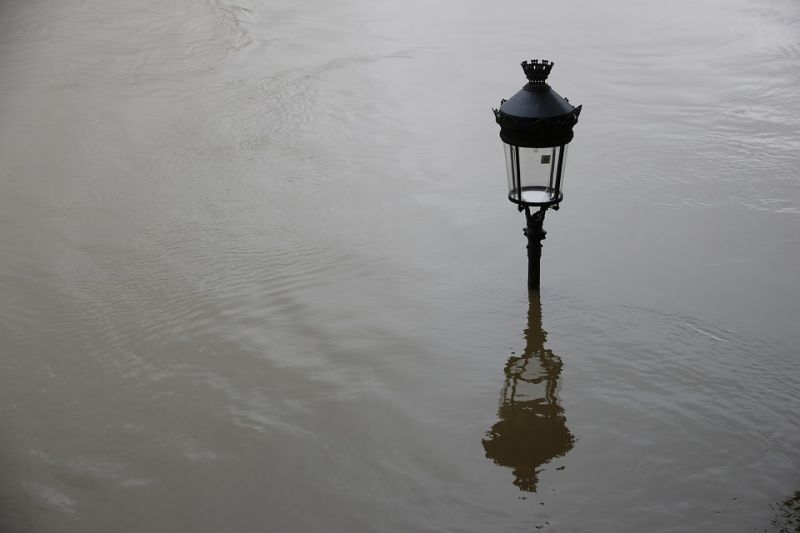Global Warming Poses Substantial Flood Risk Increase for Central and Western Europe
Published on by Water Network Research, Official research team of The Water Network in Academic
Europe is expected to see a considerable increase in flood risk in coming years, even under an optimistic climate change scenario of 1.5°C warming compared to pre-industrial levels.
A study assesses flood impacts for three scenarios – of 1.5°C, 2°C and 3°C warming – and finds that most of Central and Western Europe will experience a substantial increase in flood risk at all warming levels, and the higher the warming, the higher the risk.

Flood in Paris, France, source: Pixabay
Damage from floods across Europe is projected to more than double, from a 113% average increase if warming is kept to 1.5°C, to 145% under the 3°C scenario.
In terms of population affected, the projected increase ranges from 86% to 123%.
While the pattern for Central and Western Europe was one of a consistent increase in flood risk, the study also found that flood risk may actually decrease with warmer temperatures in some countries in Eastern Europe, but those results also show a high degree of uncertainty.
Similarly, in some countries in Southern Europe (Spain, Portugal, Greece) the initial increase in impacts at 1.5°C turns into more uncertain projections for higher warming levels, due to a substantial reduction in annual rainfall.
These findings are the result of a JRC multi-model analysis, published in Climate (Open Access Climate Science Journal).
The study improves our understanding on future trends in river flood risk in Europe while also highlighting the need to prepare effective adaptation plans for a likely increase in the severity and frequency of floods in Europe.
Modelling flood risk in Europe – global warming the biggest influence
In the framework of the HELIX FP7 Project, scientists analysed the differences in projected changes in flood risk at country scale under global warming scenarios of 1.5, 2 and 3 degrees from pre-industrial levels, and discussed reasons for the observed outcomes.
Their aim was to identify consistent, model-independent trends in flood risk in Europe due to climate change and identify the reasons for the differences and similarities among projections of river flood risk.
The three studies cover a wide range of methodologies and climate-relevant datasets (such as temperature and precipitation), hydrological and flood modelling, and impact assessment.
The comparison sheds light on the influence of the data applied and methods to assess impact projections.
Results from the three assessments confirm that climate projections are the main driver influencing future trends of flood risk.
Other factors such as the bias correction of climate projections, the method for assessing the year of exceeding global warming levels and the spatial resolution of the input data did influence the results, but only to a small degree and without affecting the direction of the projected changes in the three scenarios.
The authors also pointed out the importance of using accurate modelling of the extent of floods to achieve reliable impact estimates. At the moment, this is limited by the scarce availability of high resolution Digital Elevation Models (DEM) over large areas, where small scale features can considerably influence the distribution of floodwaters.
Read full article: European Commision
Media
Taxonomy
- River Studies
- Climate Change
- River Engineering
- Climate Change Adaptation
- Climate Change Resilience
- Flood management
- Flood damage
- Flood prediction
- Flood Risk Management
- Flood Modeling
- Flood Mapping
1 Comment
-
Sorry to disappoint. Global Warming Scam is now officially over and in the history books as the biggest crime in history. As the Earth is progressing through its normal cyclical events the equatorial regions became warmer, jet streams pulled the excess moisture to the poles, the cooler temps caused moisture to become ice which weighs more than moisture, the orbital passing of our binary star triggered many earth core, mantle , and plate tectonic responses, the oceans levels are dropping rapidly, the polar bears and penguins have the largest full ice cap in centuries. (see recent NASA, NOAA, EOS, and the National geographic special "the polar bear population explosion". Yes there is flooding naturally! A thing called CONVECTION is in full swing. Dry spells and 100 year flooding is now upon us and for the next 20 years. if meteorologist are correct. This Flood Prevention, Mitigation, & Recovery is an excellent place to teach exactly what it says. Utter nonsense is no longer needed. 1. an average size tree can drink 300 gallons a day. do the math for a 100 year flood and plant the trees required. 2. no more construction on known flood zones. 3. clean up rivers, lakes, and shorelines and install, maintain, and when monies available upgrade. 15 minutes could save you $15 trillion. No joking. Stop complaining and try it. You will be glad you did.